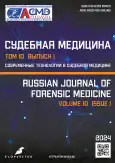Forensic examination of the biochip as a means of preventing child trafficking: a review
- Authors: Myrzabaev N.K.1, Begaliyev Y.N.1, Kuanaliyeva G.A.2, Baimakhanov A.A.1, Kuranbek Z.A.3
-
Affiliations:
- Academy of Law Enforcement Agencies Under the General Prosecutors Office of the Republic of Kazakhstan
- Al-Farabi Kazakh National University
- General Prosecutor's Office of the Republic of Kazakhstan
- Issue: Vol 10, No 1 (2024)
- Pages: 26-36
- Section: Reviews
- URL: https://journals.rcsi.science/2411-8729/article/view/254424
- DOI: https://doi.org/10.17816/fm16101
- ID: 254424
Cite item
Full Text
Abstract
The practice of using chipping to preserve the life and health of children and protect them from committing crimes is spreading in different countries.
This article examines the problems in child chipping from legal, forensic, social, and technological points of view to identify the advantages and disadvantages of the method in preventing child trafficking.
Available regulatory documents on the topic were used in the present study. This article highlights the position of the legislation of Kazakhstan regarding chipping, concludes on the compliance of legislation with modern realities, and considers chipping in compliance with the Constitution of Kazakhstan.
Ways to solve the problem of forensic examination of the biochip as a means of preventing child trafficking were proposed. A SWOT analysis of the use of a biochip was performed to resolve the issue of its application in the field under consideration, which revealed the advantages and disadvantages of the method.
The expediency and legality of chipping in minors to prevent crimes and the impact of technology on children were comprehensively studied. This study is of practical importance as it introduces into legal science a new comprehensive view of chipping and its application in minors.
Full Text
##article.viewOnOriginalSite##About the authors
Nurlanali K. Myrzabaev
Academy of Law Enforcement Agencies Under the General Prosecutors Office of the Republic of Kazakhstan
Author for correspondence.
Email: nurlanali_myrzabaev86@mail.ru
ORCID iD: 0000-0003-2268-4899
SPIN-code: 3087-8211
Kazakhstan, Koshy
Yernar N. Begaliyev
Academy of Law Enforcement Agencies Under the General Prosecutors Office of the Republic of Kazakhstan
Email: ernar-begaliev@mail.ru
ORCID iD: 0000-0001-6659-8576
SPIN-code: 1929-3392
Dr. Sci. (Legal), Professor
Kazakhstan, KoshyGuldana A. Kuanaliyeva
Al-Farabi Kazakh National University
Email: kuanalieva.guldanakz@mail.ru
ORCID iD: 0000-0003-4634-8363
Dr. Sci. (Legal), Professor
Kazakhstan, AlmatyArtur A. Baimakhanov
Academy of Law Enforcement Agencies Under the General Prosecutors Office of the Republic of Kazakhstan
Email: dratur@list.ru
ORCID iD: 0000-0002-8673-8000
SPIN-code: 9160-2394
PhD
Kazakhstan, KoshyZhebegen A. Kuranbek
General Prosecutor's Office of the Republic of Kazakhstan
Email: Zhebegenphd@mail.ru
ORCID iD: 0000-0002-0284-697X
SPIN-code: 7618-9160
PhD
Kazakhstan, AstanaReferences
- Klevno VA, Chumakov YuV, Kurdyukov FN, et al. Possibilities of posthumous computer tomography (virtual autopsy) in the event of death from mechanical asphixia. Russ J Forensic Med. 2018;4(4):22-26. EDN: VTIKTC doi: 10.19048/2411-8729-2018-4-4-22-26
- Voevodkin DV, Rustemova GR, Begaliev EN, et al. Identifying fake conclusions of forensic medical examinations using an artificial intelligence technology based on the experience in the Republic of Kazakhstan: A review. Russ J Forensic Med. 2023;9(3):287-298. EDN: EFNJIE doi: 10.17816/fm8270
- Begaliev E. On the prospects or inexpediency of introducing the institute of chipping the population. In: Paradigm of modern science through the eyes of the young: Proceedings of the XV International Scientific and Practical Conference in memory of the founders of the branch T.J. Atzhanov and A.M. Rodnov. Kostanay; 2021. Р. 25-31. (In Russ). EDN: AFDHUO
- Orakbayev AB, Kurmangali ZhK, Begaliyev YeN, et al. On the issue of using the results of a virtual autopsy in criminal investigation: A review. Russ J Forensic Med. 2023;9(2):183-192. EDN: OEERGD doi: 10.17816/fm774
- Buhayova N. Ethical and legal aspects of civil identification of a person. In: Collection of abstracts II international scientific and practical conference. Kyiv; 2021. (In Ukrainian).
- Bettinger E, Cunha N, Lichand G, Madeira R. When the effects of informational interventions are driven by salience-Evidence from school parents in Brazil. SSRN; 2022. 128 р. doi: 10.2139/ssrn.3644124
- Danilchenko Y. Modern biotechnologies and their role in reducing the possibility of committing crimes. Bulletin of the Criminal Law Association of Ukraine. 2020;(1):163-177. (In Ukrainian).
- Lockton V, Rosenberg RS. RFID: The next serious threat to privacy. Ethics and Information Technology. 2005;7:221-231.









